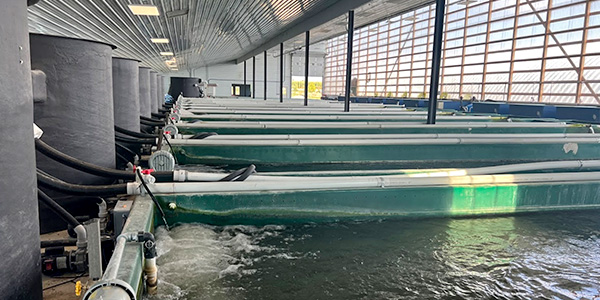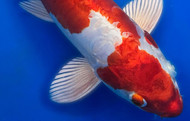Kikusui Koi Fish: Japan's 'Floating Chrysanthemum' Gains Global Popularity
Posted by Kloubec Koi Farm on 6th Oct 2025
The Kikusui koi, Japan's stunning "Floating Chrysanthemum" fish, is enchanting collectors worldwide with its distinctive metallic sheen and chrysanthemum-like patterns against a pure white base. Developed from Kohaku and Platinum Ogon varieties in the early 1800s, these graceful swimmers require precise care, including pristine water conditions and careful feeding routines. Their rarity - only about 10% meet show standards - has driven their popularity in the growing ornamental fish market, projected to reach $3.92 billion by 2028. With their symmetrical patterns, balanced colors, and fluid movements, Kikusui koi offer a fascinating blend of artistry and nature that continues to inspire both novice enthusiasts and seasoned collectors.
Origins of Kikusui Koi
Throughout history, the development of Kikusui koi traces back to the common carp, which originated over 20 million years ago. When Chinese invaders brought carp to Japan around 200 BC, they initially served as a food source.
However, the breeding history of these fish took a fascinating turn in the early 1800s when Japanese farmers in Niigata Prefecture began selecting and breeding carp for their striking color variations.
The creation of Kikusui koi emerged from a thoughtful combination of two distinct varieties: the Kohaku, known for its white body with red markings, and the Platinum Ogon, celebrated for its pure white metallic appearance.
This careful breeding process, typically involving either a Kohaku with a Doitsu Platinum Ogon or a Doitsu Kohaku with a Platinum Ogon, resulted in the distinctive Kikusui variety we recognize today.
Koi symbolism played a significant role in their development, as these fish became powerful representations of success, love, and peace in Japanese culture.
While the exact date of the first Kikusui breeding remains unknown, these refined fish have earned their place among the most admired koi varieties, particularly in recent decades.
Modern breeders like Kloubec Koi Farm maintain these traditions by ensuring each fish undergoes extensive quarantine procedures before being offered to collectors.
Distinctive Metallic Features
The distinctive metallic features of Kikusui koi set them apart in the world of ornamental fish. These enchanting creatures showcase a brilliant metallic sheen that covers their entire body and fins, creating a mesmerizing display that resembles polished metal.
What makes them truly unique is their Doitsu arrangement, where scales appear only along the lateral line or spine, enhancing their lustrous appearance.
As members of the prestigious Hikarimoyo class, Kikusui koi combine their metallic qualities with striking patterns of red or orange against a shimmery white base. The metallic skin can sometimes make these patterns appear slightly muted, but this subtle effect adds to their charm.
The consistency of their luster is vital for show-quality specimens, and judges carefully evaluate both the metallic features and scale arrangement on each Kikusui.
The rarity of high-quality Kikusui adds to their appeal, as only about 10% make it through the rigorous selection process. This selective breeding, combined with their dazzling appearance, has made them highly sought after by collectors worldwide, with exceptional specimens fetching premium prices in the international koi market.
Pattern and Color Characteristics
Distinguished by their chrysanthemum-like appearance, Kikusui koi exhibit a mesmerizing blend of patterns and colors that define their aesthetic appeal. Their pure white base serves as a pristine canvas for the overlapping scales that create their signature flower-like pattern, often complemented by scaleless flanks along its back.
The ideal Kikusui showcases notable pattern symmetry, with colors distributed evenly across both sides of the fish. The most sought-after specimens display a balanced mix of white and metallic coloration, with neither shade overwhelming the other. Some varieties feature graceful red accents, appearing in various designs such as the Tancho (a single red spot on the nose) or the vibrant Inazuma (zig-zag pattern).
Like snowflakes, no two Kikusui are exactly alike, and their patterns can vary greatly. Some display stepped patterns resembling floating stepping stones, while others showcase continuous color flows. This diversity in design, combined with their metallic sheen, makes each Kikusui a unique living artwork.
The key to their beauty lies in the harmonious color distribution and overall visual balance, characteristics that have made them increasingly popular among koi enthusiasts worldwide.
Breeding Success Stories
Pioneering breeders have achieved extraordinary success in cultivating Kikusui koi through careful breeding programs that combine Kohaku with Platinum Ogon strains.
Leading the way, in Kikusui production, the success stories from Kloubec Koi Farm highlight the significance of dedication and proper equipment in koi breeding. Their achievements stem from maintaining high quality breeders, sturdy filtration systems and carefully managing water parameters, which has resulted in consistently high-quality offspring.
Online communities like Koiphen have become advantageous platforms where breeders share their triumphs and challenges. For instance, Japanese koi breeder Masaru Saito's documented success with specialized spawning substrates and egg care has inspired many others.
These shared experiences demonstrate that while breeding Kikusui koi requires significant commitment and knowledge, the rewards of producing these graceful "floating chrysanthemums" make the expedition worthwhile.
Quality assurance extends to the Kloubec’s 80-acre farm where all koi are meticulously evaluated for body conformation, color, and skin quality before sale.
Global Impact on Koi Culture
Moving beyond individual breeding achievements, Kikusui koi have greatly shaped the global ornamental fish market, which is projected to reach $3.92 billion by 2028. The cultural significance of these "floating chrysanthemums" has surpassed Japanese borders, engaging enthusiasts worldwide through international shows and competitions.
As global trends indicate a growing appreciation for ornamental fish, Kikusui koi have become ambassadors of koi fish aquaculture excellence. Their distinctive white-base and artistic red patterns has garnered attention at prestigious koi events worldwide. he expanding market reflects not just aesthetic appeal but also therapeutic benefits, as many hobbyists find peace in observing these graceful creatures.
This global distribution has created a diverse community of enthusiasts who share knowledge, participate in shows, and contribute to the conservation of these living works of art. Leading American facilities like Kloubec Koi Farm in Amana, Iowa, have established themselves as trusted sources for premium koi varieties produced on their 80-acre operation.
Selecting Quality Specimens
Excellence in Kikusui koi selection requires a thorough understanding of their distinctive characteristics. For ideal selection, experts focus on the pristine white base color, which should exhibit a mesmerizing metallic sheen that reflects light beautifully. The orange-red markings must be vivid and well-defined, creating an artistic contrast against the gleaming white background.
Expert tips emphasize the importance of pattern placement and balance. Quality specimens may display head markings that augment rather than overwhelm, carefully avoiding coverage of the eyes. The orange patterns should stay above the lateral line, while the tail end remains graceful white. Thanks to their Doitsu (scaleless) feature, these "floating chrysanthemums" showcase their patterns with exceptional clarity.
When evaluating potential specimens, look for the signature metallic shine, or 'pika,' particularly visible in the fins, which should be opaque rather than transparent.
The best Kikusui specimens, born from the careful crossbreeding of Kohaku and Platinum Ogon parents, display multiple step patterns that create a playful, artistic layout while maintaining perfect balance in their overall appearance.
Care and Maintenance Requirements
For successful Kikusui koi care, maintaining pristine water conditions forms the foundation of their health and vigor. Regular water changes of 10-20% every few weeks, combined with efficient filtration systems and proper temperature control between 59°F to 77°F, create a superior environment for these graceful fish.
An air pump guarantees adequate oxygen levels, while purification methods help eliminate invisible waste.
Following proper feeding guidelines is equally vital for Kikusui koi health. High-quality commercial koi food should be offered 2-3 times daily, with portions that can be consumed within minutes.
Like seasonal changes in nature, feeding schedules should adjust throughout the year, reducing portions during colder months when metabolism slows. To keep mealtime interesting, occasional treats like freeze-dried shrimp can be included – think of it as serving dessert to these aquatic gourmets!
Regular pond maintenance, including debris removal and equipment checks, completes the care routine.
A quarantine protocol for new additions protects the existing collection from potential diseases, while daily monitoring of water quality parameters guarantees these living jewels remain healthy and lively for years to come.
Similar to practices at Kloubec Koi Farm, extensive health procedures should be implemented before introducing new koi to your pond.
Show Standards and Judging
When evaluating Kikusui koi in competitive shows, judges assess these metallic-scaled beauties through an extensive set of established criteria. The judging criteria focus on key elements including conformation, color quality, pattern balance, and the fish's overall elegance.
A Kikusui's body should be broad and symmetrical, with well-proportioned fins and a graceful swimming style demonstrating natural poise.
In koi competitions, judges pay particular attention to the metallic sheen that makes Kikusui so distinctive. The pattern should feature an even distribution of white and red, with clean edges between colors. The markings should stop at the lateral line, leaving the lower body pristine white. At the same time, the head may display a balanced combination of both colors with a characteristically white nose.
Teams of experienced judges work together to guarantee fair evaluations, considering current appearance and future potential. They examine every detail, from the deep, shiny rays in the fins to the white tail tip, while watching for any disqualifying factors such as missing fins or signs of illness.
Conclusion
The Kikusui koi, with its shimmering metallic scales contrasting against pristine red patterns, represents both artistic excellence and careful cultivation. While traditional Japanese koi embody centuries of dedicated breeding, the Kikusui's rising global prominence demonstrates the progressive nature of this living art form. Modern breeders continue refining these "floating chrysanthemums," balancing classic standards with innovative techniques. The Kikusui stands as an indication of how cultural traditions can flourish and modify across international frontiers.
Bring your pond to life with vibrant, healthy koi.
Explore our full selection here:
www.kloubeckoi.com/koi-for-sale


